Welcome to our first adventure in beekeeping; installing our first hives. This adventure took place on May 3, 2012.
Nucs
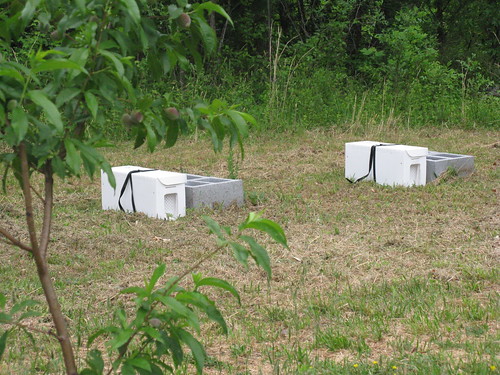 Here are our nucs waiting to be transferred to hives behind our young peach tree. The hives will sit on the cinder blocks.
Here are our nucs waiting to be transferred to hives behind our young peach tree. The hives will sit on the cinder blocks.This is a closer look at one of the nucs. Each nuc contains five frames of an already established colony. Buying a nuc has several advantages over simply buying a package of bees. A package is not an established colony and the queen has to be in her own container so the other bees can acclimate to her. In a nuc, the bees and queen are already established together and already have brood to strengthen the colony once it is in a hive.
Lemon Balm
Bees like lemon balm. Rub fresh lemon balm on new frames to make them more pleasant for the bees.
Frames
My dear beekeeper here is holding a Honey Super Cell frame. It is a plastic, fully drawn frame and we are trying it out in one of our hives. I only know of two brands of fully drawn plastic cell: Honey Super Cell and PermaComb. PermaComb is only available for medium supers (learn more about supers below) and Honey Super Cell comes in sizes to fit both medium and deep supers. Since we are using both (deeps for colony needs and mediums for honey production), we went with Honey Super Cell. Many beekeepers swear by the ease of these frames and we are hoping to have a similar experience with it. The plastic should reduce wax moth problems and the forced small cell size greatly reduces incidents of varroa mites without the need to medicate the colony. Here you see my hubby lightly spraying the frame with sugar water to encourage the bees to use the frame.
We are using a standard wax-dipped plastic foundation frame in the other hive. We are using the plastic base to reduce wax moth. The bees will have to draw out comb on this plastic foundation and here you see my hubby lightly spraying the frame with sugar water to encourage the bees to use the frame.
Hive Tool
The hive tool is a must for a beekeeper. This is how you separate sticky frames.
Hive Installation
Transfer the nuc frames to the new hive in the same order they are in the nuc. This is the instruction given to us by the experienced beekeeper we purchased the nucs from as well as from many beekeepers online. I don't see any reason not to. In this picture, the bottom board and deep box are in place. The bottom board is sort of a tray with a wire mesh that helps reduce varroa mite infestations without the need to medicate the colony. You can learn more about this at GreenBeehives. The deep super is merely a wooden box with no top or bottom that frames can be hung in.
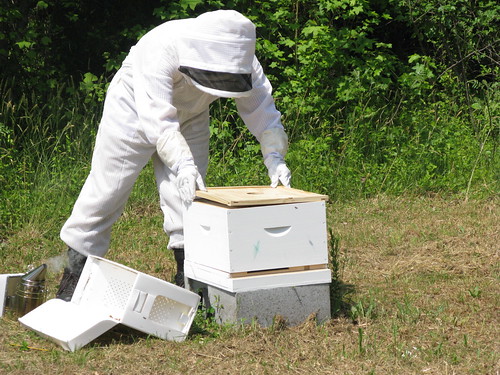 In a new colony, the bees need time to establish in the first deep and need to be fed sugar water until nectar flow is established. The next layer of the hive installation is the feed tray which is a board with a hole in the center where bees can access a bucket feeder.
In a new colony, the bees need time to establish in the first deep and need to be fed sugar water until nectar flow is established. The next layer of the hive installation is the feed tray which is a board with a hole in the center where bees can access a bucket feeder. 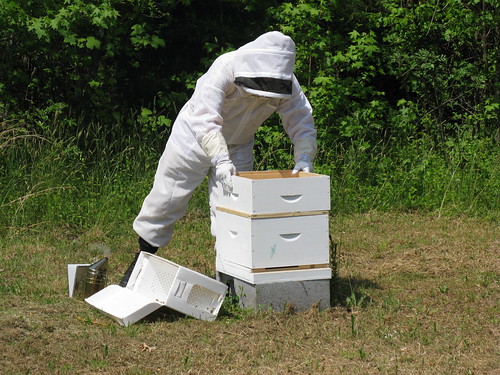 A medium super (another box with no top or bottom that frames can hang in) is placed on top of the feed tray to enclose the feed bucket.
A medium super (another box with no top or bottom that frames can hang in) is placed on top of the feed tray to enclose the feed bucket. The feed bucket goes upside down in the medium super over the hole in the feed tray where the bees can access the sugar water feed that will act as a nectar flow until a local nectar flow can be established.
The feed bucket goes upside down in the medium super over the hole in the feed tray where the bees can access the sugar water feed that will act as a nectar flow until a local nectar flow can be established.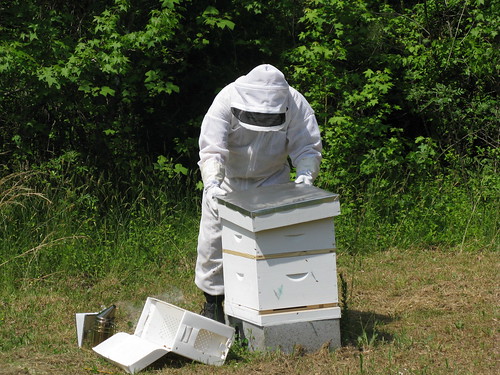 Finally, the telescoping cover goes on top of the hive. It overhangs the rest of the hive and keeps things dry in the rain.
Finally, the telescoping cover goes on top of the hive. It overhangs the rest of the hive and keeps things dry in the rain.
Here's a pic of the deep super with nuc frames and new frames installed:
All Done
We were short a feeder bucket, so did not put the medium on the second hive yet. We will add it in the next day or two. Since our bees came in a nuc, they should be fine waiting a short time for supplemental food. When the bees have filled up about eight of the frames in the deep, another deep will be added on top of the first deep to give the bees more room to expand. When the bees are well established, the feeder will be removed and frames for honey production will be placed in the medium super.
Some notes on our experience
Agitating the bees - At one point, a nuc that still contained frames fell over. The bees clearly sounded agitated, but I noticed no aggression. They did not appear to be attempting to sting my husband at all and they certainly did not swarm him. They settled down pretty quickly.
Pacifying the bees - It does not take a lot of smoke to pacify the bees. Just a couple of puffs are usually plenty, with an occasional additional puff or two if the bees get active at the top of the frames. Honestly, I'm not convinced the additional puffs are necessary in most cases.
Resources
Note - I am not an affiliate with any of these companies and make no money by providing the below information. These are products we feel are useful and we hope others will find them useful, too.
Ultra Breeze® Ventilated Beekeeping Suit is our suit of choice.
Check out this YouTube video showing how a professional beekeeper handles her bees. I really think we gained a lot of confidence watching this video.
The Honey Super Cell frames website: If you purchase them from the link to Simpson Bee Supply (linked on the HSC site), you will see they warn that the frames are slightly warped. We did not find this to be an issue. You have to call Simpson to order as their online shopping cart is not functional. This is a mom and pop dealer and they are not very internet savvy, but our frames arrived two days after we ordered them and we are happy with them.
There is no website I know of for PermaComb, but here is the contact information for the man who sells it. They can only be purchased during certain times and, if you want them, you need to be added to his mailing list so you will receive notification. A production run only occurs if there is enough interest to run 1,000 frames. I did email Mr. Seets and he answers very quickly. You should know that Dadant bee supply company carries a product with a similar name (PermaCell), but it is my understanding that the Dadant product is plastic foundation and not fully-drawn plastic frames. I tried to email Dadant to clarify this, but their response did not answer my question.
John Seets, National/International Distributor
PermaComb Systems
Catonsville, MD.
john.seets@ngc.com
410-471-4335
Larger versions of the images I used here can be found at my Flickr set.







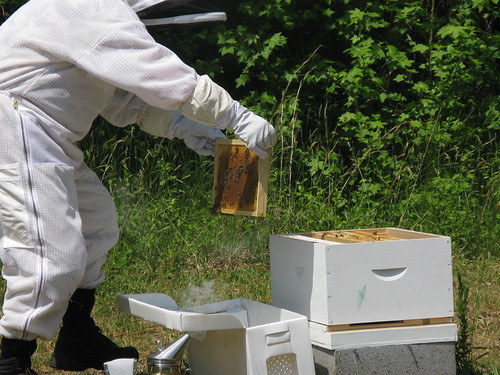
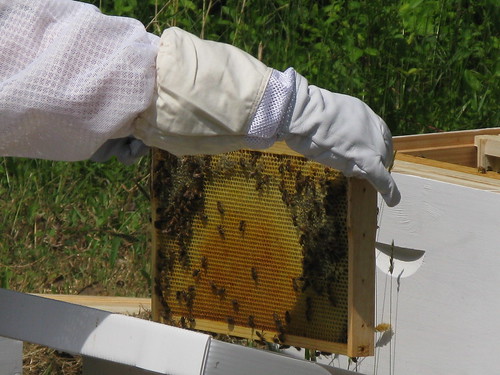
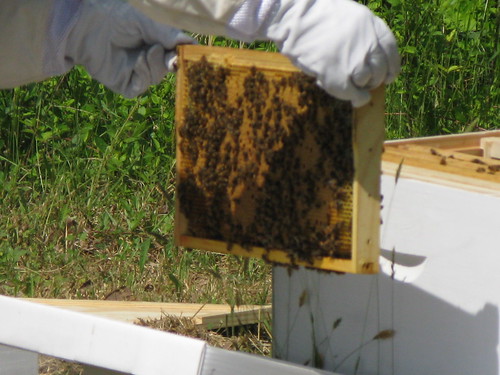


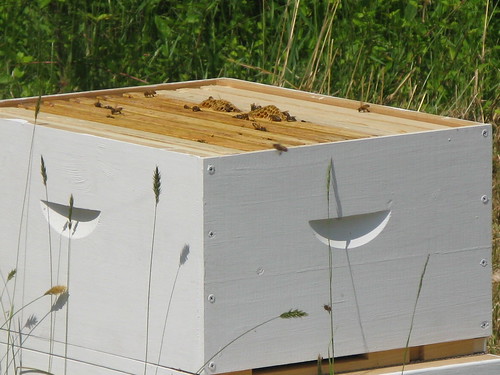
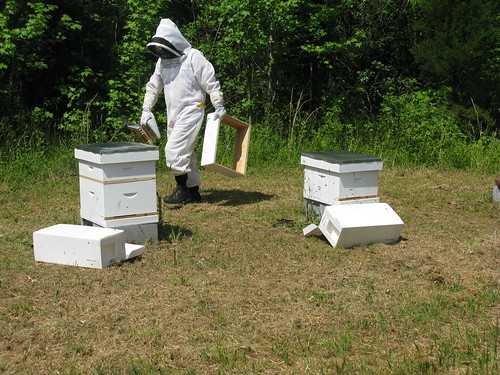
No comments:
Post a Comment